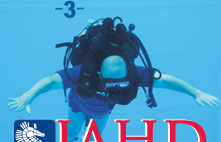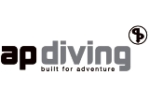NEWS & MOVIES ARCHIVE
Disabled diver around the world – French Polynesia
To make experience such as rodeo on a rubber boat I had to travel to the other end of the world. Without Branka, of course, it would not work. Preparations for the journey were profound and long-term. When everything was ready we packed our bags, my crutches and some scuba gear, and went on the journey. Through Brnik, Paris and Los Angeles, we happily landed on the island Tahiti in French Polynesia. Our trip lasted from 11th August to 4th of September. The idea for the trip has a long beard, but about this some other time.
French Polynesia consists of 118 islands that are scattered over the surface of 3,900 km2. The main groups of islands are: the Tuamotu, Gambier, Marquises, Tubuai, and the Society Islands. This is an area in the Pacific Ocean, which is as big as Western Europe, where lives a population of less than 300,000 people.
The largest island in French Polynesia is Tahiti, but we stamped our prints in coral sand, next to Tahiti, also on islands Bora-Bora, Rangiroa and Mo´orea. French Polynesia is a diving destination, but we included some slacking and sightseeing in our journey as well.
First a few words about diving. Organization of the dives took place under the usual procedure and normal circumstances. I contacted the group Top Divie, which has diving centres distributed throughout French Polynesia. First of all, I inquired what the conditions are, and of course, I explained them that I am a diver with disabilities. Given that, we have decided to dive in Tahiti, Bora-Bora and Rangiroa. In Tahiti and Bora-Bora there are no specifics worth mentioning, as far as diving is concerned, on Rangiroa the divers are driven to the diving sites by rubber boats. Driving with rubber boat was something new for me, but together, by using the help of the buddy from the group Top Dive we carried out a jump into the water, and mounting the SCUBA gear in water, without major problems. This time I decided to dive without an attendant, who would care only for me, because this would further increase the costs, and I went diving as a regular member of the group, which usually counted from four to six divers.
Polynesian underwater world is extremely rich. We could admire almost everything that crawls and swims under water here (except the Hammerhead shark).
In Tahiti and Bora-Bora conditions for diving are good, because the water is warm; there are no strong currents under water, and no excessively high waves on the surface. On Rangiroa diving is more challenging. Rangiroa atoll has the second largest lagoon in the world, with a length of 110 kilometres. Diving takes place at locations Tiputa Pass and Avatoru Pass. In fact, these are two straits through which water flows in or out from the lagoon. Therefore, the conditions under the water are constantly changing, currents are very strong, and you can come upon a strong counter current. This happened to me, and despite the help of a buddy, who dragged me towards the stream, I could not overcome the current, and we had to continue the dive with the flow.
With some skill and goodwill diving is also possible for people with disabilities who use wheelchairs. Piers on Tahiti and Bora Bora are accessible, on Rangiroa it is necessary to overcome some stairs before embarking on to the boat.
The guys at Top Dive have no experience, when it comes to diving for persons with disabilities, but they learn fast. Before the dive, you just have to talk to the diver, who leads the group, and draw attention to all specific details, and that is it.
It is worth to book and pay the dives in advance. Prices are in the range from 60 € to 65 € (with discount) for a dive, and it does not matter whether you use your own diving equipment or rented. I should note that not all the diving centres have compensators with integrated weights and I therefore had to drag it, as a piece of personal baggage on to the aircraft.
All hotels, where we were staying are equipped with rooms adapted for people with special needs. Swimming pools, restaurants, buffets, bars and public toilets are normally accessible with a wheelchair. For a day on the beach you will require the help of some muscular Polynesian, but this is not a problem, because the Polynesians are very friendly and always willing to help.
Diving centre is located within the hotel and is also accessible for people using wheelchairs.
The journey was beautiful, but also expensive. The dives were unforgettable, for food in general, and apartments in Tahiti we paid too much.
On the way home, the plane from Los Angeles to Paris was three hours late, and we therefore missed the flight from Paris to Zagreb. Unplanned we stayed one night in Paris, our luggage travelled the other way, and to Gorenjska circuitously travelled another five additional days, but it was worth it!
Text: Peter Majcen - LG
Photographs: BB, LG, TOPDIVE-Rangiroa
Some advertising:
Hotels:
- Tahiti: InterContinental Tahiti Resort & Spa
- Bora-Bora: Bora-Bora Pearl Beach Resort
- Rangiroa: Kia Ora Resort
Diving:
- TopDive
4. 09. 2016
Production & design: Creativ, Novi mediji d.o.o.













